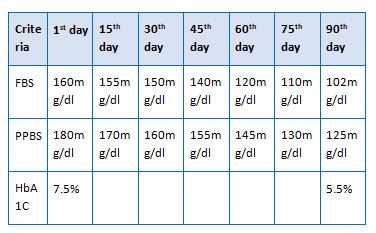Ayurvedic management of Prameha - A Single Case Study
DOI:
https://doi.org/10.21760/jaims.8.12.44Keywords:
Madhumeha, Type-2 diabetes mellitus, Prameha Chikitsa, Pathya Ahara ViharaAbstract
Diabetes mellitus (DM) type 2 is one of the global problems of the present day and it is gaining more attention. It is expected to continue as a major health problem and leads to serious complications. India is one of the top 5 countries with the highest prevalence of DM. The IDF Diabetes Atlas (2021) reports that 10.5% of the adult population (20-79 years) has diabetes, with almost half unaware that they are living with the condition. By 2045, IDF projections show that 1 in 8 adults, approximately 783 million, will be living with diabetes, an increase of 46%.[1] The signs and symptoms of diabetes can be correlated to Prameha of Ayurveda. The management of Prameha is mentioned in Ayurveda as preventive and curative aspects. Ayurveda has recommended an appropriate use of Oushadha Yogas along with proper Pathya (wholesome) Ahara, and Viharas. On the same principles a patient was treated at OPD basis, this case report analyses the same. A male patient, aged 45 years, diagnosed case of Prameha 5 years back presented with dryness in the mouth, increased frequency of micturition, Excessive thirst, weakness of the body, and burning sensation at the sole. The treatment planned was use of Shamana Oushadhis along with proper Pathya (wholesome) Ahara, and Vihara for three months. After three months of treatments results were compared. There was a marked reduction in signs and symptoms like burning sensation, numbness, excessive thirst, and increased micturition.
Downloads
References
IDF Diabetes Atlas. International Diabetes Federation. Available from: https://idf.org/about-diabetes/facts-figures/
Waghe. Textbook of Roga Nidana & Vikriti Vigyana; First Edition; Nagpur; Rashtra Gaurav Publication; 2019. p. 204.
Vagbhata. Astanga Hrudaya, Nidanasthana, Atisaara grahaniroga Nidana, 8/30, edited by Pt. Hari Sadasiva Sastri Paradakara Bhisagacarya, Chaukhamba Sanskrit Sansthan, Varanasi, Reprint: 2009. p. 497.
Vidhyadhara Shukla, Ravidatta Tripathi. Charaka Samhita of Acharya Charaka. Reprint edition, Varanasi; Chaukhambha Sanskrit Pratishthan; 2006. p. 169.
Bramhanand Tripathi. Madhav Nidana of Acharya Madhava. Varanasi; Chaukhambha Surbharati Pratishthana; 2011. p. 4.
Vidhyadhara Shukla, Ravidatta Tripathi. Charaka Samhita of Acharya Charaka. Reprint edition. Varanasi; Chaukhambha Sanskrit Pratishthan; 2006. p. 168.
Sahasrayogam (3rd ed.) Dr Ramnivas Sharma, Surendra Sharma (Eds.), Vol. 318, Chaukambha Sanskrit Sansthan, Delhi (2002). p. 4.
Tripathi Brahmanand, editor. Sharangadhara Samhita, Sutrasthana, 1st ed. Ch. 15, Ver. 19-20. Varanasi: Choukambha Sanskrit Pratisthana; 2013. p. 200.
http://aamjournal.in/fulltext/70-1528447830.
R H Singh. Charak Samhita of Agnivesha, Chawkhambha Surabharati Prakashana, Varanasi. 1st edition, reprint, 2011; 2: 1042.
Bedarkar PB, Ranpara N, Sawaliya V, Nariya MB, Prajapati PK, Patgiri B. Antihyperglycemic activity of Nishamalaki-An Ayurvedic formulation of Turmeric and Emblica officinalis. EJBPS. 2017; 4: 853-6.
Dr G. Prabhakar Rao (Ed.), Sahasrayogam: compendium of 1000 ayurvedic formulations (1st ed.), Chaukhambha Publications (2016), pp. 106-107.
https://www.ayurmedinfo.com/2017/12/21/dia-p-capsule/
https://www.researchgate.net/publication/327076993_Therapeutic_Role_of_Yoga_in_Type_2_Diabetes
Shastri Satya Narayana, Charaka Samhita, Chaukhambha Bharti Academy, Reprint edition, 2016 Sutra Sathana ch 27.20, P-529.
https://journals.indexcopernicus.com/api/file/viewByFileId/396435.pdf
Srichamroen A, Thomson ABR, Field CJ, Basu TK. In vitro intestinal glucose uptake is inhibited by galactomannan from Canadian fenugreek seed (Trigonella foenum graecum L) in genetically lean and obese rats. Nutrition Research, 29, 2008, 49-54.















